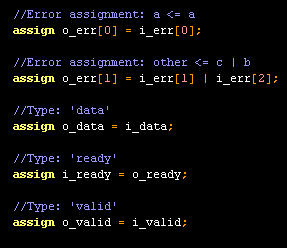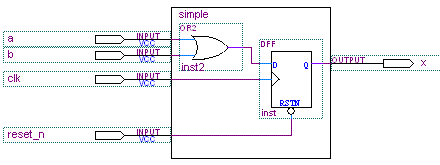An unexpected puzzle came up - a component which seems simple, but turns out to be rather annoying to implement. A good test case, I say. I'll make this quick and brief - the new component files are attached below if you want to dig deeper.
The component's Family/Genus/Species is Adapter/Avalon-ST adapter/Avalon-ST Error Adapter.
Adapter
An adapter, generally speaking, is a simple component which is inserted in between a pair of components of a particular type, to accomplish some sort of conversion. A typical example is the data-width adapter (to allow connection of, say, an Avalon-MM master and slave, or an Avalon-ST source and sink, which happen to have different data widths). A good adapter is fairly simple, does only one thing, and is completely parameterized according to information from the interfaces it connects to.
Avalon-ST Adapter
Adapters of this description are tailored to the particular set of signals supported by Avalon-ST. These adapters understand the specific direction of Avalon-ST signals (e.g. the "data" signal is an output from a source, and an input to a sink; the "ready" signal is an input to a source, and an output from a sink).
Avalon-ST Error Adapter
This adapter does straight-through wiring on all Avalon-ST signals except for one, the "error" signal. All signals other than "error" are required to have the same bit width on both the source and sink which the adapter is connects to. And that's where the regularity ends: the "error" signal is wonderfully free to vary. The source may have no error signal, or a multiple-bit one; likewise on the sink. With mismatched widths, how can the adapter do its job? Well, one more thing about the error signal: each individual bit of the error signal has a "type", which is an arbitrary string, or the special string "other". Given a "type map" for all the source and sink error bits, there are some simple rules for error signal adaptation:
- Like-type error bits are directly connected
- If the sink has an error bit of type "other", it's driven by the logical OR of any as-yet unconnected source error bits (type "other" or otherwise).
- If any undriven sink error bits remain, they are driven with 0.
- Any remaining unconnected source error bits are ignored.
Huzzah, a new base class
Since any Avalon-ST adapter will have a mess of same-width signals which wire straight through, and then maybe one signal which needs some special treatment, it makes sense to derive a base class (avalon_st_adapter) from europa_module_factory, from which all Avalon-ST adapters will further derive. This base class calls into a derived class method for doing any special signal handling, then does straight-through wiring on any remaining (non-special) signals. The derived class is concerned only with doing its special job on its special signal(s), and managing any options relevant to the special signal(s).
Command-line args - limited to simple numerals and strings thus far
But that's far too limiting. Here's why: avalon_st_adapter is a component in its own right, though really a silly one. Its generation parameters are a set of signal descriptions (name, width and type) on its "in" (driven by the source) and "out" (driving the sink) interfaces. It's natural to think of these input parameters as a simple pair of hashes, keyed on signal type. But I want to retain the guideline of pure command-line specification of parameters. I could encode those hashes as comma-separated lists of things, to be massaged and processed by a script into proper perl data structures, but that seems like a lot of work. What to do? No problem, I simply pass my hashes in perl syntax on the command line, appropriately escaped, and "eval" does the parsing for me. Validation of these non-scalar fields presents a bit of a nuisance, but nothing that can't be dealt with. For now, I simply validate against the field "type" (HASH, ARRAY, CODE, undef-for-scalar), but nothing stops me from (in the future) defining nested parameter data structures which encode the same sorts of value sets and ranges that I already use for scalar parameters.
To the basic set of port declarations which form avalon_st_adapter's generation parameters, avalon_st_error_adapter adds two more hashes, in which the "in" and "out" interface error bit types are described.
Testing, testing...
Once I had the basic avalon_st_adapter class working, and a skeleton implementation of avalon_st_error_adapter, I found myself doing lots of exploratory refactoring. I worried that I'd break the functionality, which I was happy with. Solution: unit tests. In my case, this means, for each component, a handful of test-case scripts, each of which produces an HDL module, and a top-level test script, "test.sh". After making a change, I run ". test.sh", which runs all the test cases and diffs the output HDL against a set of "known-good" files in a subdirectory. Occasionally, a change is made which does change the output HDL, and for those cases, I carefully examine the new and old files to convince myself that the new HDL file can replace the old known-good one (or note that I've created a new bug, and fix it).
Avalon-ST signal type "error": wonderfully free form
Actually, this is rather an annoying adapter, due to the unconstrained nature of the "error" signal. You'll note that all of the nuisance is concentrated in avalon_st_error_adapter::make_special_assignments().
HDL comments
I went a bit out of my way to produce comments on the adapter assignments, to label the signals and error bit types. Here's a nice ascii block diagram of error adapter test case "3":

... and here's a snippet of of test case 3's HDL implementation, showing handy assignment comments:

That's it for now. For all my most ardent fans, I'm attaching the new avalon_st_adapter and avalon_st_error_adapter components, along with their test scripts and known-good HDL files. I'm also including the latest version of europa_module_factory, which changed slightly to support the new command-line processing.
components20071114.zip


